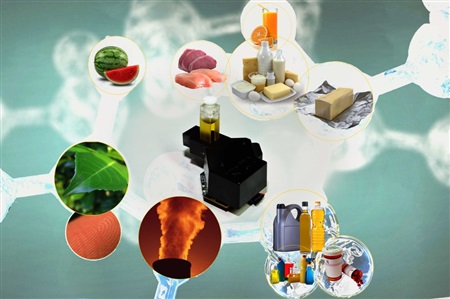SSZTBV1 december 2015
This guest blog comes from Hakki Refai, chief technology officer for Optecks , a TI DLP® Design House dedicated to developing products and solutions for DLP technology based applications.
Spectrometers are highly sophisticated and versatile optical tools for examining the make-up of any state of matter – solid, liquid, or gas – making them useful for monitoring and investigative purposes in a wide variety of industrial and research settings. In all spectrometers, the material is illuminated by a broadband light source – one that emits many wavelengths (or colors) of light – and the material reflects, absorbs, or otherwise interacts with the light to change how much power returns to the spectrometer at each wavelength. If all spectrometers perform the same basic sets of operations, what makes the DLP NIRscan™ Nano Evaluation Module (EVM) so special?

Most current spectrometers use one of two common technologies – rotating diffraction gratings or large linear arrays of detectors – to finely sample what happens to the light over the range of wavelengths. The required detector sizes, materials, and costs, along with the need for high-precision mechanical systems that are isolated from the outside world, prevent these devices from realizing the full potential of spectroscopic measurement. The DLP NIRscan Nano EVM, in contrast, utilizes DLP technology, in conjunction with specially designed interrogation modules to increase measurement sensitivity and flexibility while reducing the measurement time and cost -- all in a compact, highly portable package that can go virtually anywhere.
What aspects of DLP technology and the interrogation modules provide the DLP NIRscan Nano EVM with such distinct advantages in performance, and what is the nature of these advantages? First, let’s look at how using a digital mircromirror device (DMD) and its controlling DLP board transform the process of wavelength sampling.
- The DMD mirrors are in a 2-dimension array creating an advanced filter allowing more light than the linear array detectors used in other spectrometers. The many columns of mirrors increase the range of wavelengths that can be captured by a single configuration of the DLP NIRscan Nano EVM.
- More optical power can be collected at each wavelength versus a fixed filter into the small aperture typical represented in linear array pixels. Every mirror in a column reflects the same set of wavelengths, and the optical detector can have a larger area without sacrificing wavelength resolution, both of which increase the ability of the DLP NIRscan Nano EVM to accurately sense small phenomena.
- DLP technology is easy to calibrate and highly resistant to temperature and vibration.
- The DMD can be controlled to optimize the wavelength analysis to the specific needs of a given application. Are you interested in what happens at only a few wavelengths, and don’t care much about the rest? DLP technology can instruct the DMD to only activate the columns corresponding to the wavelengths of interest, so that the DLP NIRscan Nano EVM does not waste time or resources to measure what is happening at the other wavelengths. Do you want to balance resolution, sensitivity, and measurement time? DLP technology can select the number of columns, the number of mirrors per column, and the time that the column is activated. All of this happens in the same device – no need to buy a new device for the next project.
Interested to know how different modules can be integrated with the DLP NIRscan Nano EVM? Check out “Part Two” of this blog series next week.
Want to learn more about spectroscopy and its applications? Check out a few resources:
- Learn more about how DLP technology enables spectroscopy from this overview page.
- Watch this video about how to get started using the DLP NIRscan Nano EVM.
- The TI Designs Reference Design can help you design your near-infrared spectrometer.